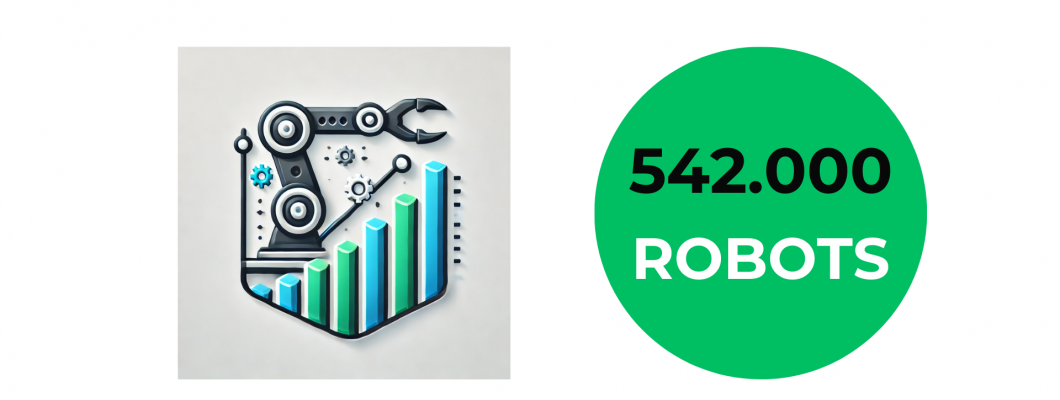
The latest figures from the International Federation of Robotics (IFR) show a striking transformation in factory automation over the past ten years. Annual installations of industrial robots rose from 221,000 units in 2014 to 542,000 in 2024, more than doubling the world’s robot “workforce.” That trajectory implies a compound annual growth rate of roughly 9–10%—a pace that reshaped production lines across automotive, electronics, metals, logistics, and more.
A decade in five beats
2014–2018: The first surge
Installations climbed steadily from 221k (2014) to 423k (2018). This was the era when electronics assembly and automotive final-line applications embraced high-throughput, high-precision robots, and when easier programming and safer, more compact designs lowered adoption barriers for new plants.2019–2020: A pause, not a pivot
Deployments slipped to 387k (2019) and 390k (2020). Trade tensions, late-cycle auto softness, and pandemic disruptions delayed capex decisions. Crucially, the dip did not reverse the decade’s structural drivers—labor scarcity, demand volatility, and quality pressures—which would soon reassert themselves.2021–2022: The rebound and records
As factories caught up on deferred investments and reconfigured lines for resilience, installations jumped to 526k (2021) and peaked at 553k (2022). Bottlenecked supply chains, the e-commerce boom, and electrification programs in automotive (battery packs, power electronics) all pulled robot demand forward.2023–2024: High plateau
The market consolidated at 541k (2023) and 542k (2024). That near-record “shoulder” suggests a maturing base, macro caution in certain regions, and lead-time normalization—yet still a historically elevated run-rate that is far above pre-pandemic levels.Ten-year take
From 221k to 542k installs, factories added over 3.9 million robots cumulatively during the period (back-of-the-envelope), while the annual flow more than doubled. In other words: automation became not an experiment, but an operating system.
Why factories kept buying
Labor realities. Aging workforces and chronic hiring gaps in repetitive, physically demanding roles pushed managers toward automation to stabilize throughput and safety.
Quality and traceability. Vision-guided assembly, force-controlled fastening, and automated inspection improved first-pass yield while generating data essential for compliance and continuous improvement.
Product mix volatility. Shorter product cycles—especially in consumer electronics and EV platforms—favored flexible, reprogrammable cells over fixed tooling.
Cost and capability curve. Robots, end-of-arm tooling, and motion control got cheaper, smarter, and easier to integrate. No-code/low-code interfaces and digital twins accelerated commissioning.
Resilience and reshoring. After 2020, many firms diversified supply chains. Automation helped offset higher labor costs in near-shore locations.
What the plateau means
A flat line at ~540–550k units in 2022–2024 isn’t stagnation; it’s digestion. Three forces are at play:
Macro timing. Interest rates and capex cycles slowed greenfield projects in some regions.
Bottleneck shift. The constraint moved from robot arms to skilled integration—software, cell design, safety, and changeover tooling.
Mix change. Growth broadened from classic auto body shops to battery manufacturing, intralogistics, food & beverage, and metals, where payback depends more on process engineering than on the robot itself.
Where the next wave comes from
AI-native cells. Foundation-model vision, real-time path planning, and policy learning are pushing robots from rigidly programmed motions to perception-driven manipulation (bin picking, kitting, parcel handling) with higher autonomy and less downtime.
Collaborative and mobile systems. Safer cobots and AMR + arm combos will penetrate SMEs and brownfield sites, where footprint and integration cost matter most.
Software-defined automation. Digital twins, simulation-based scheduling, and standardized cell APIs will compress design-to-deployment timelines and enable rapid changeovers—critical for high-mix, low-volume manufacturing.
Sustainability and energy. EV supply chains, battery recycling, and precision machining for efficient drivetrains all favor robotic consistency and traceability.
Human-robot teamwork. Expect more hybrid stations that reserve humans for judgment-heavy tasks while robots handle ergonomically risky or highly repetitive steps, boosting both throughput and safety metrics.
Implications for executives
Think cells, not arms. Competitive advantage sits in process engineering—fixtures, grippers, vision, and software—more than in the robot SKU.
Design for changeovers. If your product mix shifts quarterly, bake in quick-swap tooling, modular conveyors, and recipe-driven programming from day one.
Invest in people. The tightest bottleneck is integrator and maintenance talent. Upskill technicians on safety, PLCs, robotics programming, and data collection.
Measure the data exhaust. Treat every robot move, torque curve, and inspection frame as a dataset for predictive maintenance and adaptive quality control.
Stage the journey. Start with high-ROI, ergonomics-heavy tasks; expand to AI-assisted manipulation; then connect islands of automation into a line-level digital twin.
Bottom line: The world now installs over half a million industrial robots every year—a new normal that reflects structural labor trends, quality demands, and the maturation of the automation stack. After a decade of growth and a recent plateau at record levels, the next leg will be defined less by raw arm counts and more by intelligence, integration, and adaptability—how well factories turn robots into resilient, data-driven production systems.
